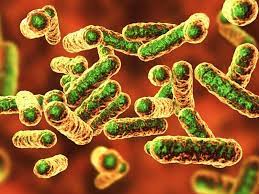My fascination with Bartonella all started with two little pills.
My husband, Russ, was diagnosed with three tick-borne pathogens: Borrelia burgdorferi, Bartonella henselae, and Babesia duncani. I researched each of the unwanted invaders, but my efforts quickly focused on Borrelia, the bacteria causing Lyme Disease. Lyme gets most of the headlines, so it must be the most significant factor in Russ’s case, right?
Then we ran out of one of Russ’s prescriptions. He was on broad-spectrum antimicrobials including eight different antibiotics. I knew we had an appointment with the doctor soon, so I figured missing one of them for a few days couldn’t hurt anything. If only that were true.
The missing drug was rifabutin, an antibiotic that’s effective at killing slow-growing, intracellular bacteria. Lyme-literate doctors often use rifabutin and its close cousin rifampin to target Bartonella. After missing just two pills of rifabutin, Russ was a mess. He complained of back pain, felt severe fatigue, became angry and irritable, and battled waves of anxiety. Within 24 hours of being back on the drug, his symptoms subsided. Now Bartonella had my full attention.
 As I researched, the dichotomy between the simplicity of the colloquial name, “cat scratch fever,” and the complexity of Bartonella-associated disease struck me. According to the Centers for Disease Control and Prevention or CDC, Bartonella is transmitted from a cat to a human during a scratch, bite, or lick of an open wound. The bacterial infection leads to a low-grade fever, persistently enlarged lymph nodes, and a pustule at the scratch site. Most cases resolve without treatment, and modern medicine questions the use of antibiotics to shorten the course of the disease.
As I researched, the dichotomy between the simplicity of the colloquial name, “cat scratch fever,” and the complexity of Bartonella-associated disease struck me. According to the Centers for Disease Control and Prevention or CDC, Bartonella is transmitted from a cat to a human during a scratch, bite, or lick of an open wound. The bacterial infection leads to a low-grade fever, persistently enlarged lymph nodes, and a pustule at the scratch site. Most cases resolve without treatment, and modern medicine questions the use of antibiotics to shorten the course of the disease.
But when I dug deeper into the research, the reality of the infection sent chills down my spine. The bacteria grow slowly, often avoiding the attention of the immune system. Left unchecked, the disease can produce severe neurologic symptoms, including brain inflammation, seizures, and even mental illness. Also, a cat scratch or bite is only one of many ways Bartonella can travel. Biting insects such as lice, fleas, and ticks can also pass this hitchhiker from an animal reservoir to a human host.
Back to Russ. Unfortunately, his story doesn’t end well. He was diagnosed with late-stage Alzheimer’s months before we identified the root cause of his illness, and, despite treatment, we couldn’t keep him from descending further into his dementia. His journey included massive bouts of depression, suicidal thoughts, anxiety, and even hallucinations. As I picked up the pieces left by his illness, I wondered how many of his symptoms linked to Bartonella.
I’ve since connected with Dr. Amanda Elam, the CEO and co-founder of Galaxy Diagnostics. Her co-founder, Dr. Ed Breitschwerdt, is one of the world’s leading experts on Bartonella, and their company sits on the front lines of Bartonella research. They regularly diagnose tragic cases that have fallen through the massive chasms of traditional medicine.
One such story involves a 14-year-old boy. This boy—who I will call Michael—was once easy-going, athletic, and at the top of his class. Then, suddenly, Michael was plagued with homicidal thoughts and hallucinations. He refused to leave the house and believed that a demon cat wanted him to kill his younger sibling. For 18 months, Michael remained psychotic despite four hospitalizations and multiple psychiatric medications. He was diagnosed with schizophrenia and obsessive-compulsive disorder, and his parents had no choice but to institutionalize him.
But his parents didn’t give up and continued to dig for the root cause of his illness. Through a long winding road, they connected with Dr. Breitschwerdt, who used his state-of-the-art assays to detect evidence of Bartonella henselae and Bartonella vinsonii berkoffi in Michael’s blood. Michael’s parents weren’t sure that Bartonella was the cause of his psychosis, but they were hopeful. Over the next few months, doctors treated their son with a series of antibiotics that included both rifampin and rifabutin. His disease progressively subsided until his delusions evaporated. He returned to high school, and two years later, Michael graduated as the valedictorian of his class. He is now a freshman at a major university, studying medical anthropology and considering a teaching career. The Journal of Central Nervous System Disease published a medical case report on Michael’s story, and an upcoming issue of Epic Magazine will feature his family’s tragic, yet triumphant, journey.
 Another patient story is that of Colonel Nicole Malachowski, USAF, Retired. Nicole is a nationally recognized fighter pilot and military officer, who was inducted into the National Women’s Hall of Fame in 2019 for her breadth of professional achievements. Her 21-year military career included flying 26 combat missions, becoming the first woman Thunderbird pilot, serving as a White House Fellow, and commanding the 333rd Fighter Squadron at Seymour Johnson Air Force Base. After returning from survival training in eastern North Carolina, Nicole suffered from flu-like symptoms and a bullseye rash and was diagnosed with a spider bite. Shortly after that, she was restationed to Newport, RI, and found an engorged tick on her leg.
Another patient story is that of Colonel Nicole Malachowski, USAF, Retired. Nicole is a nationally recognized fighter pilot and military officer, who was inducted into the National Women’s Hall of Fame in 2019 for her breadth of professional achievements. Her 21-year military career included flying 26 combat missions, becoming the first woman Thunderbird pilot, serving as a White House Fellow, and commanding the 333rd Fighter Squadron at Seymour Johnson Air Force Base. After returning from survival training in eastern North Carolina, Nicole suffered from flu-like symptoms and a bullseye rash and was diagnosed with a spider bite. Shortly after that, she was restationed to Newport, RI, and found an engorged tick on her leg.
Despite consultation with over 24 different military and civilian doctors, her health declined drastically over the next three years. Doctors repeatedly told her “it couldn’t be Lyme” because she had been “successfully treated” with a short five-day course of oral doxycycline. None of her doctors ever tested for other tick-borne infections. The highly accomplished Colonel was left wheelchair-bound and barely able to communicate.
Through persistence, Nicole found her way to Dr. Nevena Zubcevik and the Dean Center for Tick-Borne illness. The center ran an extensive panel of tests, including a screen for Bartonella using Galaxy Diagnostics. Nicole tested positive for Borrelia burgdorferi, Borrelia hermsii, Anaplasma, Babesia microti, and Bartonella henselae. The Dean Center, in coordination with a multi-disciplinary team at Massachusetts General Hospital and her military medical team, treated each pathogen one at a time, allowing Nicole to discover which pathogen was connected to which symptoms. When she treated Bartonella with rifampin, she named the infection “The Beast.”
Nicole talked about her journey in her interview with Tick Boot Camp and later sat down with me to share her experience. After her tick bite in Newport, RI, Nicole suffered progressive mental health issues. The formerly unflappable fighter pilot suddenly struggled with uncharacteristic irritability, anger, and bouts of rage. She heard mysterious sounds like someone was whispering in her ear, and she felt crippling anxiety that made her paranoid and reclusive. But within three days of starting rifampin, these symptoms began to fade. Within weeks, they were gone. Her head cleared, and her mood stabilized. Since she concluded treatment for Bartonella, she hasn’t experienced any psychiatric symptoms.
The more I learn about Bartonella, the more I realize that “cat scratch fever” is a gross underestimation of its impact. So why are these little, gram-negative bacteria so misunderstood? The short answer is that they’re hard to find. Bartonella spends most of its time hiding within cells, cycling in and out of the bloodstream, making it difficult to detect in a diagnostic test. Dr. Breitschwerdt and Galaxy have spent years tackling this challenge. They developed a proprietary growth medium to amplify the slow-growing bacteria from a blood sample. They also perform multiple blood draws to improve the odds of capturing the Beast in a test tube.
Breitschwerdt’s research into Bartonella continues. Earlier this year, he published a pilot case-control study revealing that 11 of 17 patients with schizophrenia tested positive for Bartonella. That correlates to 65 percent of the patients tested, five times higher than the rate seen in healthy controls.
His research begs the question: how many chronic mental health conditions are caused by this elusive bacteria? Is it truly “the Beast” within? An accurate diagnosis was life-changing for Michael and Nicole, and I wish Russ’s diagnosis had come sooner. Over 47 million Americans experience mental illness. Hopefully, those caused by Bartonella will quickly find the answers they so desperately need.
Nicole Bell is an award-winning author of What Lurks in the Woods, a raw and gripping memoir about her family’s journey with Alzheimer’s and tick-borne illness.

 As I researched, the dichotomy between the simplicity of the colloquial name, “cat scratch fever,” and the complexity of Bartonella-associated disease struck me. According to the Centers for Disease Control and Prevention or CDC, Bartonella is transmitted from a cat to a human during a scratch, bite, or lick of an open wound. The bacterial infection leads to a low-grade fever, persistently enlarged lymph nodes, and a pustule at the scratch site. Most cases resolve without treatment, and modern medicine questions the use of antibiotics to shorten the course of the disease.
As I researched, the dichotomy between the simplicity of the colloquial name, “cat scratch fever,” and the complexity of Bartonella-associated disease struck me. According to the Centers for Disease Control and Prevention or CDC, Bartonella is transmitted from a cat to a human during a scratch, bite, or lick of an open wound. The bacterial infection leads to a low-grade fever, persistently enlarged lymph nodes, and a pustule at the scratch site. Most cases resolve without treatment, and modern medicine questions the use of antibiotics to shorten the course of the disease. Another patient story is that of Colonel Nicole Malachowski, USAF, Retired. Nicole is a nationally recognized fighter pilot and military officer, who was inducted into the National Women’s Hall of Fame in 2019 for her breadth of professional achievements. Her 21-year military career included flying 26 combat missions, becoming the first woman Thunderbird pilot, serving as a White House Fellow, and commanding the 333rd Fighter Squadron at Seymour Johnson Air Force Base. After returning from survival training in eastern North Carolina, Nicole suffered from flu-like symptoms and a bullseye rash and was diagnosed with a spider bite. Shortly after that, she was restationed to Newport, RI, and found an engorged tick on her leg.
Another patient story is that of Colonel Nicole Malachowski, USAF, Retired. Nicole is a nationally recognized fighter pilot and military officer, who was inducted into the National Women’s Hall of Fame in 2019 for her breadth of professional achievements. Her 21-year military career included flying 26 combat missions, becoming the first woman Thunderbird pilot, serving as a White House Fellow, and commanding the 333rd Fighter Squadron at Seymour Johnson Air Force Base. After returning from survival training in eastern North Carolina, Nicole suffered from flu-like symptoms and a bullseye rash and was diagnosed with a spider bite. Shortly after that, she was restationed to Newport, RI, and found an engorged tick on her leg.
